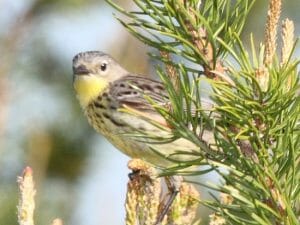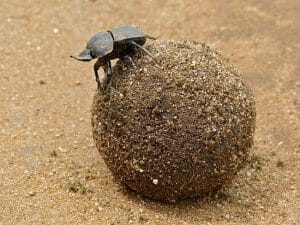Ecological Niche Definition
In ecology, a niche is the role or job of a species in a habitat. The word niche comes from the French word nicher, which means “to nest.” An ecological niche describes how a species interacts with, and lives in, its habitat. Ecological niches have specific characteristics, such as availability of nutrients, temperature, terrain, sunlight and predators, which dictate how, and how well, a species survives and reproduces. A species carves out a niche for itself in a habitat by being able to adapt and diverge from other species. Modern-day ecologists study ecological niches in terms of the impact the species has on its environment, as well as the species’ requirements.
According to the competitive exclusion principle, two species cannot occupy the same ecological niche in a habitat if they are competing for the same resources. When species compete in a niche, natural selection will first move to lessen the dependence of the species on the shared resources. If one species is successful, it reduces the competition. If neither evolves to reduce competition, then the species that can more efficiently exploit the resource will win out, and the other species will eventually become extinct.
Examples of Ecological Niches
Kirtland’s Warbler
Kirtland’s warbler is a rare bird that lives in small areas in Michigan’s northern Lower and Upper Peninsulas. The niche of Kirtland’s warbler is the jack pine forest, and the forest must have very specific conditions. Jack pine forests with areas of over 80 acres are ideal for this species. Specifically, these forests must have dense clumps of trees with small areas of grass, ferns and small shrubs in between. Kirtland’s warbler nests on the ground beneath the branches when the tree is about 5 feet tall, or around 5-8 years old. When the tree reaches about 16-20 feet tall, the lower branches start to die, and the bird will no longer nest beneath the tree branches.
Jack pine forests remained virtually undisturbed during Michigan’s lumber boom in the early 1800s because white pine was a much more valuable. The consistent availability of young jack pines for nesting was generated by naturally occurring wildfires in this habitat. When the lumber boom ended in the late 1800s, the wildfires continued and allowed the jack pine to spread and create more habitat for Kirtland’s warbler. The species population reached its peak from 1885-1900. Humans began to alter this niche by fighting and putting out forest fires. Over time, this severely affected the Kirtland’s warbler population. Large areas of jack pine forest were designated for habitat management via logging, burning, seeding and replanting in the 1970s, and the species recovered.

The image above shows a female Kirtland’s Warbler, Dendroica kirtlandii.
Dung Beetle
As the name implies, dung beetles eat dung, both as adults and as larvae. They live on all continents except Antarctica. Dung is plentiful throughout the world, and over time, the dung beetle has learned to exploit it as a resource, and create its own niche. Dung beetles are known for the way in which they roll dung into a ball before transporting it. These balls area buried in an underground burrow to either be stored as food or used as brooding balls. The female lays eggs in the brooding ball and the larvae hatch inside. When they reach adult size, the beetles dig out of the ball and work their way to the soil surface. The actions of dung beetles serve several important functions in their habitat. Digging burrows and tunnels turns over and aerates the soil. The buried dung releases nutrients into the soil that benefits other organisms. In addition, the beetle’s use of dung leaves less available for flies to breed on, thus controlling some of the fly population.

The image above shows Kheper nigroaeneus, the Large Copper Dung Beetle, on a ball of dung.
Xerophytic Plants
Xerophytic plants have developed several adaptations to living in dry ecological niches. The adaptations evolved to help save water stored in the plant and to prevent water loss. Examples of xerophytes are cacti and aloe vera, also called succulents. These plants have thick fleshy leaves that store water, and long roots to reach water deep underground. Other adaptations that xerophytic plants use include the ability to move or fold up their leaves, dropping their leaves during dry periods, a waxy coating to prevent evaporation (called the cuticle) and thick hairy leaf coverings. The surface of plant leaves features stomata, which are tiny mouth-like structures that take in carbon dioxide and release oxygen and water. Plants usually open their stomata during the day and close them at night. Succulents do the opposite in order to reduce water loss during the heat of the day.
Extremophiles
Organisms can create ecological niches in some of the most inhospitable places on earth. Extremophiles are organisms, primarily eukaryotes, adapted to and thriving in areas of environmental extremes. The suffix -phile comes from the Greek word philos, which means loving. The type of extreme environment describes these organisms. Some examples are acidophiles (best growth between pH 1 and pH 5), thermophiles (best growth between 140°F and 176°F), barophiles (best growth at high pressures) and endolithic (growing within rock). Some organisms, called polyextremophiles, have adapted to more than one extreme. The study of extremophiles is important to the understanding of how life originated on earth and what life could be like in other worlds. Extremophiles are also important in biotechnology because their enzymes (called extremozymes) are used under extreme production conditions.
Quiz
1. A niche is _________________.
A. a succulent plant.
B. another name for a pile of beetle dung.
C. the role or job that a species has within a habitat.
D. none of the above.
2. Which rule states that two species cannot occupy the same ecological niche in a habitat if they are competing for the same resources?
A. The competitive exclusion principle.
B. Natural selection.
C. The theory of general relativity.
D. Evolutionary biology.
3. An extremophile species is _________________ if it grows best at a low pH.
A. thermophilic
B. acidophilic
C. barophilic
D. endolithic
References
- -phile. (n.d.). In Dictionary.com. Retrieved from http://www.dictionary.com/browse/-phile.
- “Dung beetles.” (2017, May 10). Retrieved from https://australianmuseum.net.au/dung-beetles.
- Ecological niches. (n.d.). In Encyclopedia Britannica online. https://www.britannica.com/science/community-ecology/The-process-of-succession#ref588111.
- Extremeophile. (n.d.). In Encyclopedia Britannica online. Retrieved from https://www.britannica.com/science/extremophile.
- Feehan, J. (2017, May 10). What are dung beetles? Retrieved from http://dungbeetleexpert.com.au/what-are-dung-beetles.
- “Kirtland’s Warbler Dendroica kirtlandii.” (2017, May 10). Retrieved from http://www.michigan.gov/dnr/0,4570,7-153-10370_12145_12202-32591–,00.html.
- Niche. (n.d.). In Encyclopedia Britannica online. Retrieved from https://www.britannica.com/science/niche-ecology.
- Niche. (n.d.). In Merriam Webster online. Retrieved from https://www.merriam-webster.com/dictionary/niche.
- OpenStax. (2017). Concepts of Biology
- Pedruski, M., Fussmann, G., & Gonzalez, A. (2016). A network approach reveals surprises about the history of niches. Ecosphere. 7(3), 1-12. doi: 10.1002/ecs2.1266.
- Xerophyte. (n.d.). In Encyclopedia Britannica online. https://www.britannica.com/plant/xerophyte.
